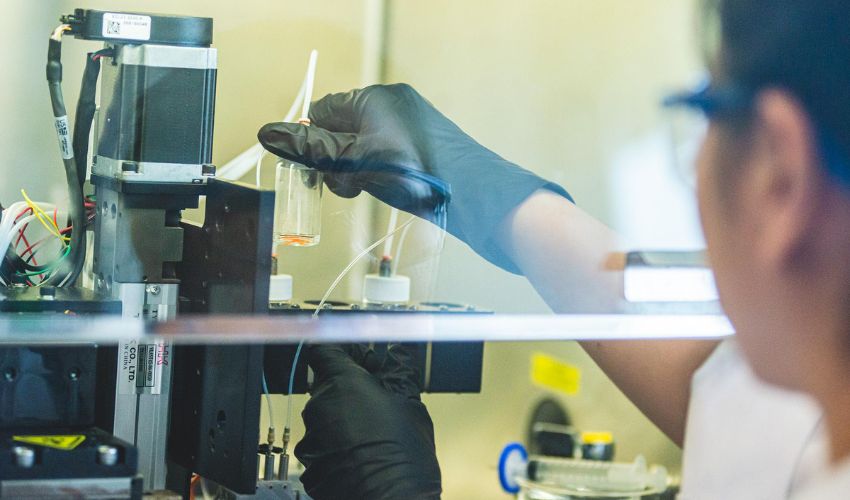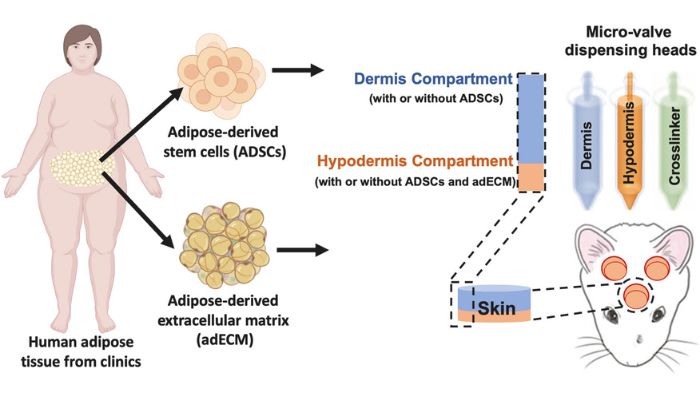New 3D Printed Skin Integrates Hair Follicles and Could Heal Wounds

3D printing is used in a very wide variety of areas in medicine, where it has opens up new ways of treating patients. In recent news, a research team from Penn State has succeeded in making 3D printed living skin which has the potential to integrate hair follicles using human tissue and the fat cells and supporting structures taken from it. As part of the project, the researchers aimed to restore injured rat skin to its original state.
Producing thin layers of skin from a 3D printer has already been achieved in the past. However, the current study is the first to successfully print a complete and living system consisting of several layers of skin, such as the lowest layer of skin, the hypodermis, which is made up of fat and connective tissue and is responsible for support above the skull. The special feature here is that the skin can be printed during the ongoing operation using the bioprinting technology developed by the team, whereby the visible outermost skin layer (the epidermis) is not printed, as this is automatically developed by the underlying middle layer.

Photo Credits: Bioactive Materials
The results of the research project were recently published in the journal Bioactive Materials. Professor of engineering science and mechanics, of biomedical, who led the international research collaboration, Ibrahim T. Ozbolat, further explained, “Reconstructive surgery to correct trauma to the face or head from injury or disease is usually imperfect, resulting in scarring or permanent hair loss. With this work, we demonstrate bioprinted, full thickness skin with the potential to grow hair in rats. That’s a step closer to being able to achieve more natural-looking and aesthetically pleasing head and face reconstruction in humans.”
How to Reconstruct Skin and Hair With 3D Printing
The research project used a 3D bioprinter with three chambers, each of which was filled with a different component. The researchers worked with adipose tissue from patients at Penn State Health Milton S. Hershey Medical Center. The aim was to obtain the fat to extract the extracellular matrix, which gives the tissue structure and stability. Part of the bio-ink was to be produced in this way.
Furthermore, for the production of the second component of the bio-ink, stem cells were also extracted from the fatty tissue, which can be used to develop different cell types. The researchers filled the third pressure chamber with a coagulation solution. Ozbolat further explained:
“The three compartments allow us to co-print the matrix-fibrinogen mixture along with the stem cells with precise control. We printed directly into the injury site with the target of forming the hypodermis, which helps with wound healing, hair follicle generation, temperature regulation and more.”
According to Ozbolat, the hypodermis is directly involved in the process by which stem cells become fat and this process is crucial for several vital processes, including wound healing. It also plays a role in the hair follicle cycle, particularly in promoting hair growth. In their research, Ozbolat and his team found that the joint supply of matrix and stem cells is crucial for the formation of the hypodermis.
Furthermore, in their experiments, the fat cells may have altered the extracellular matrix in such a way that they were more supportive of hair root formation. The researchers’ findings could thus hold great potential for reconstructive facial surgery and the treatment of hair growth in humans in injured or diseased areas. You can find out more in the published study HERE.
What do you think of this 3D printed skin with hair follicles? Let us know in a comment below or on our LinkedIn, Facebook, and Twitter pages! Don’t forget to sign up for our free weekly newsletter here, the latest 3D printing news straight to your inbox! You can also find all our videos on our YouTube channel.
*Cover Photo Credits: Penn State






